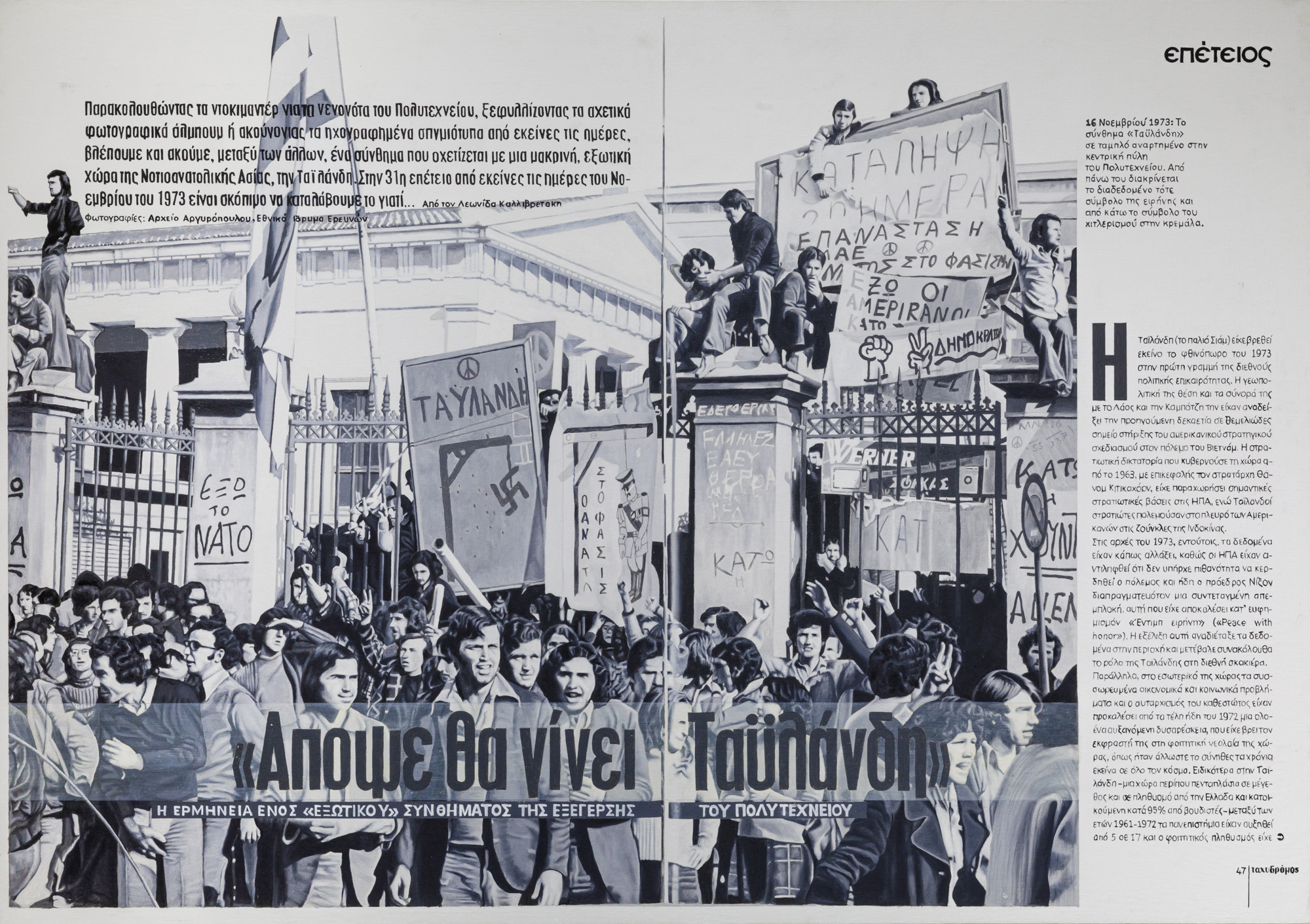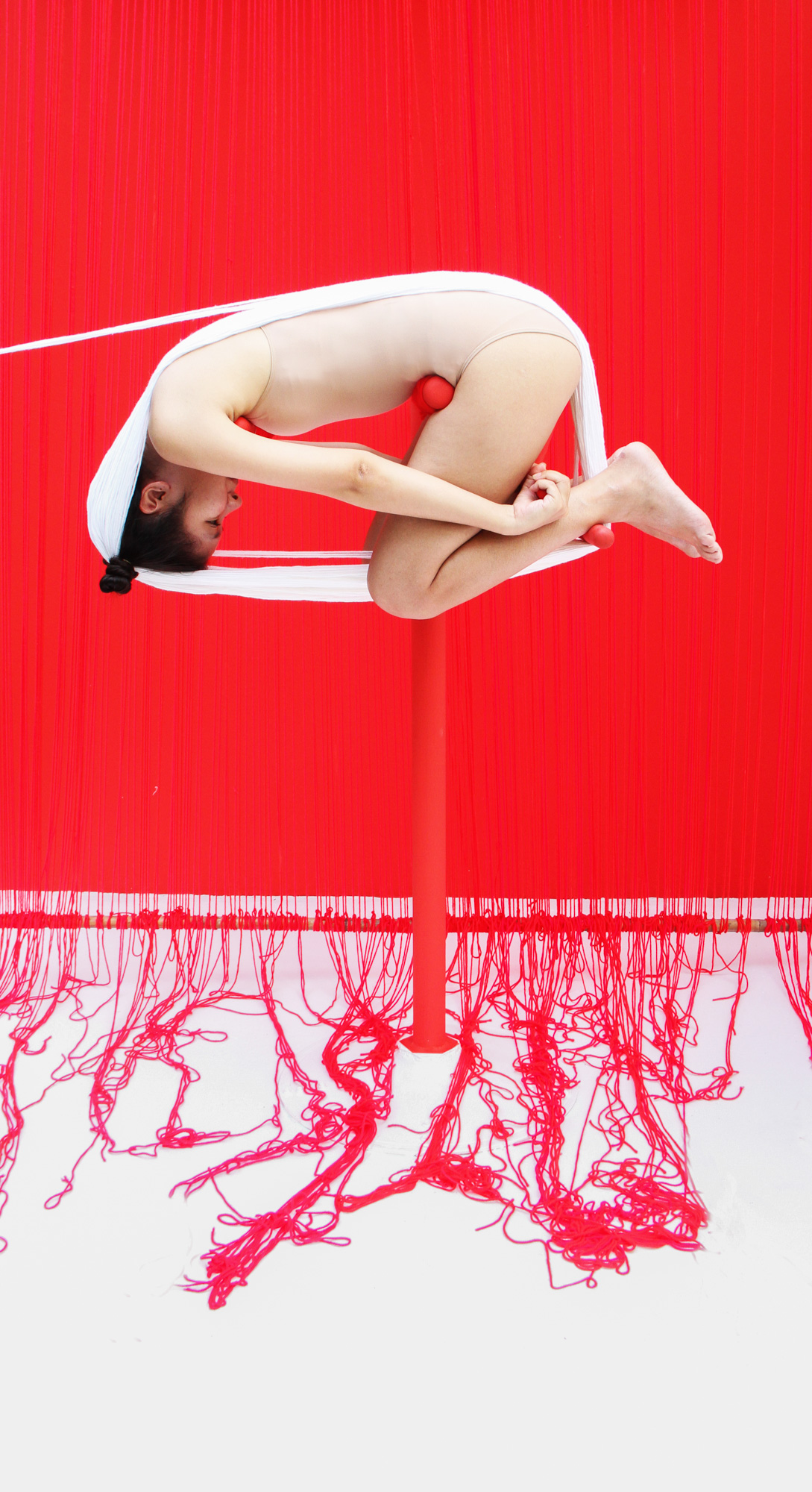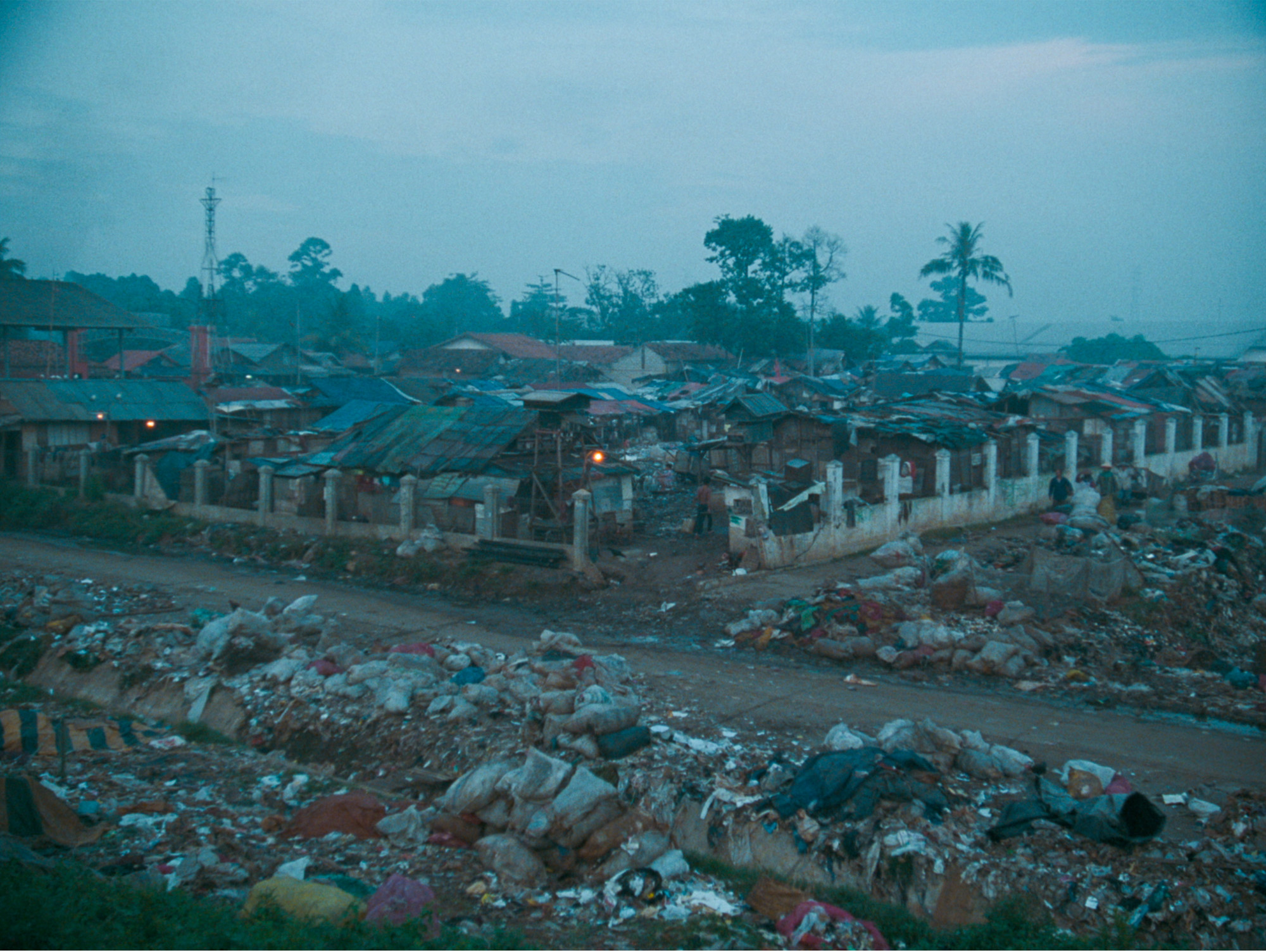Chiang Mai: “Errata”
By Barrak Alzaid

ARIN RUNGJANG, And then there were none (Tomorrow we will become Thailand) (detail), 2016, 17 oil-on-canvas paintings, dimensions variable. Courtesy the artist and MAIIAM Contemporary Art Museum, Chiang Mai.
“Errata”
MAIIAM Contemporary Art Museum, Chiang Mai
It’s easy enough to rush through MAIIAM Contemporary Art Museum’s first room, filled with artifacts from the founder’s family that detail their historical role in Thailand’s ruling class. I wasn’t here to linger in antiquities, but to view “Errata,” part of “Collecting Entanglements and Embodied Histories,” a dialogue initiated by the Goethe-Institut between the collections of the Singapore Art Museum, Galeri Nasional Indonesia, MAIIAM, and Berlin’s Nationalgalerie.
“Errata” began in the museum’s expansive white- walled entry hall, where Ho Tzu Nyen’s The Critical Dictionary of Southeast Asia: F for Fold (2021) invited one to pause and reflect on the contexts explored in the exhibition. The white pages of Ho’s accordion book zigzagged across the length of a long white plinth like castle ramparts, belying their gleaming flip side: “poor images” downloaded and printed in shiny gold- tinged foil. The first entry to catch my eye was “decay,” which draws a connection between the relatively fast rate of decomposition in the acidic Malayan soil and the geopolitical forces that have absorbed and assimilated the peoples of Southeast Asia by demarcating lines across lands over successive regimes. “Southeast Asia is a machinery of rot,” Ho writes, “An empire of decay.” The next entry is “corruption,” an injunction against the contagious transmission of power through lineage—except the rulers are inoculated with myth and law to gain untouchable qualities.
Curated by Gridthiya Gaweewong, artistic director of Bangkok’s Jim Thompson Art Center, “Errata” offered knowledge, materiality, and time as crucial lenses to understand the impact of the structures of power and resistance throughout Southeast Asia’s history. Rather than spotlighting oppressive regimes, Gridthiya revealed how artists’ interventions transform discourse using the tools of the oppressor, presenting audiences with strategies and alternative narratives. As I roamed the exhibition, however, I wondered if any of the works could overcome the limitations Audre Lorde censured when she stated, “the master’s tools will never dismantle the master’s house.”
Several artists take on the Ramayana, an epic myth that circulated through South and Southeast Asia and was instrumentalized to legitimate the rulers’ divinity. These artists foreground previously marginal and subjugated characters, as exemplified by the video I Don’t Want to be Part of Your Legend (2004), where Arahmaiani shifts the focus to the goddess Sita in order to challenge the subjugation of women’s bodies in Javanese society. In the epic, Sita’s husband, Rama, commands her to prove her chastity, and she flings herself into a fire, emerging unscathed. The female body remains in service of the male’s, trapped in its framework. Arahmaiani depicts Sita as dry leaves that catch fire and burn, returning to the earth as fuel, and also evokes the practice of suttee, in which a widow sacrifices herself on her deceased husband’s funeral pyre. The work reminds viewers that patriarchy operates through multiple levers, including myth, to disempower and marginalize women.

KAWITA VATANAJYANKUR, Spinning Wheel, 2018, still from video installation: 5 min 35 sec. Courtesy the artist and MAIIAM Contemporary Art Museum, Chiang Mai.
Works responding to the Cold War and its legacy demonstrate how artists engage with knowledge production and dissemination via mass media. In Television Commercial for Communism (2011–12), five flat screen televisions faced inward toward the center of the room, depicting The Propeller Group as designers of a marketing campaign for communism. The viewer is afforded a 360-degree perspective from the inner circle, able to see key words drafted on a whiteboard like “fellowship,” “community,” “feeling safe,” and “boring.” A smaller screen hung on the wall portrays live action and animated versions of the banal result. The collective draws attention to the way in which ideology and propaganda can be transmuted into terms palatable for public consumption. Meanwhile, Arin Rungjang’s And then there were none (Tomorrow we will become Thailand) (2016) consists of photorealistic paintings of newspapers from Greece and Thailand. The series emerged when the artist encountered Greek news clippings depicting the November 1973 student uprisings protesting the military junta in Greece. His eyes landed on a quote from an article, “Tomorrow we will become Thailand”—a nod to the Thai popular uprising of October 14, 1973, which ended the military dictatorship of Thanom Kittikachorn. The artist demonstrates how popular movements can seize control of media like radio and newspaper to inspire and fuel one another.
An archive-based section, “When Attitude and Form Collide,” interrogated the idea of art institutions as infallible containers of knowledge and authority. At its heart was documentation of ERRATA (2004–05), Koh Nguang How’s project tracing the Singapore Art Museum’s incorrect dating of Chua Mia Tee’s painting National Language Class to 1950. In the original catalogue, the 0 in the corner is smudged—a mistake that depoliticized the work. Through intense archival research, Koh revealed the correct date to be 1959, which charges the painting with symbolic and political meaning; this was the year the ex-British colony attained self-governance, and so National Language Class must be portraying a group of Chinese students learning Malay, the newly designated national language of Singapore.
Other artists highlighted embodied connections to systems of power. Melati Suryodarmo’s Exergie – Butter Dance (São Paulo) (2000)—in which she attempts to dance on hunks of butter in high heels—and Kawita Vatanajankur’s acrobatic movements around a human-size spool in The Spinning Wheel (2018) gesture to the extreme burden capitalism places on the body, a repository for memory and pain. The artists subject their bodies to joyless, painful tasks, not unlike the labors women are subjected to around the world. The final piece was an unfortunate misfire, left to perform its pernicious shame behind a black curtain in a corner viewing room. Jeroen de Rijke and Willem de Rooij’s video Bantar Gebang (2000) is a reminder of the limits of art and aesthetics in effecting systemic change. A long shot of a Jakarta slum and its residents adopts the colonizer’s removed gaze. Unlike many of the other artists, the filmmakers absent themselves from their work, except for an awkward cough halfway through the film. Far below them, people pass across the screen, unaware they are being filmed. The closing credits do not acknowledge these individuals, despite the artists’ stated aim to shed light on their struggles. An attempt at confronting inequality becomes exploitative poverty porn, and fails to confront the filmmakers’ own privilege and positionality within the history of Indonesia’s colonization by the Dutch.

JEROEN DE RIJKE and WILLEM DE ROOIJ, Bantar Gebang, 2000, still from digital video converted from 35mm color film: 11 min 33 sec. Courtesy the artists.
When Gridthiya met me later, she took me back to the first alcove I had skipped. For her, “Errata” begins in what she terms the “genesis room,” which she curated as a permanent installation. It portrays the institution’s history, revealing the power and privilege of the founder’s family while also presenting commissioned works that encompass subtle yet direct critiques of power. The genesis room houses a portrait of museum owner Eric Booth’s great-grandaunt Chao Chom Iam, a royal consort to King Rama V and namesake of MAIIAM. It hangs above two books. On the left is Far From Home (1907), compiling the English, French, and German translations of King Rama V’s personal chronicles of his first official European tour in 1898, which marked the introduction of what was then known as Siam onto the global stage. Beside it, like a piece of errata, is Paphonsak La-or’s book Far from Home (2017), featuring a series of paintings of mountain peaks in 13 different countries where Thai activists have lived in exile, following the military coups in 2006 and 2014, and subsequent crackdowns on civil society.
It sometimes seems like we can never exist outside the institutions that subjugate us, but Audre Lorde also said, “In our world, divide and conquer must become define and empower.” “Errata” offered a model for how to inhabit institutions, to critique and transform them. We have the tools to remake society, but they must be wielded by the right people
.jpg)






